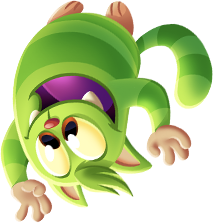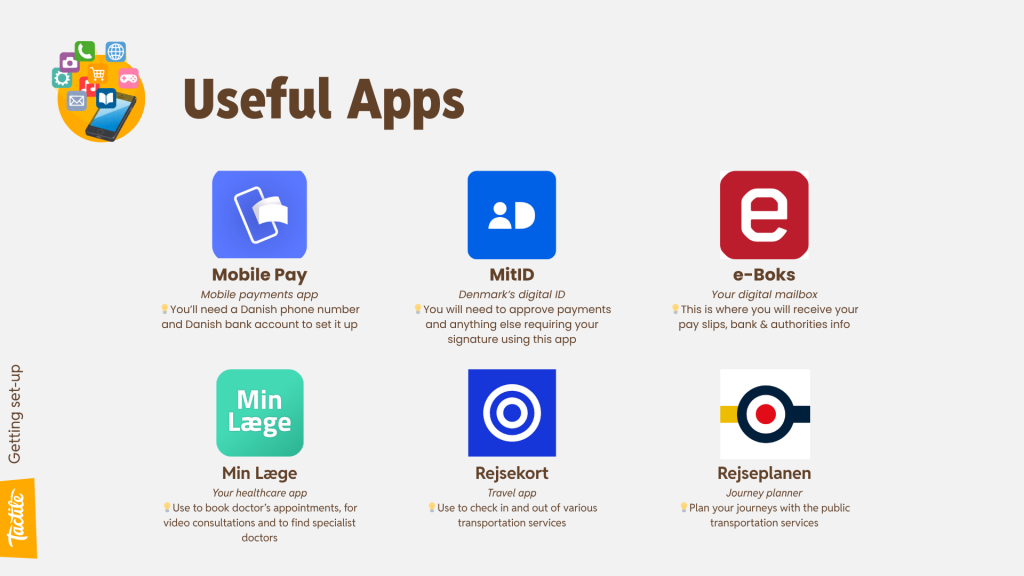Relocating to a new country is a life-changing experience! Whilst there’s a lot of positive emotions around it, the move can also be stressful and overwhelming. How will it be once you get to your destination? Will it be easy to get settled in? Are the public institutions well organized? Is there a good public transportation system in place that is easy to navigate?
At Tactile, we relocate people from all over the world and many of us have been through this experience, asking ourselves the same questions and feeling the same concerns. So to help you get better prepared for your potential move to Denmark, we have put together a comprehensive Relocation Guide.
Depending on where you are in your hiring journey with Tactile, you can refer to one of the 3 sections of the guide, which holds the key information for you to know at this point in time:
- If you’re currently in the interview process with Tactile
- If you’ve signed your employment contract and are about to move to Denmark
- If you have just arrived to Denmark
We hope that this guide helps you to feel more prepared to start your new life in Denmark 🙌
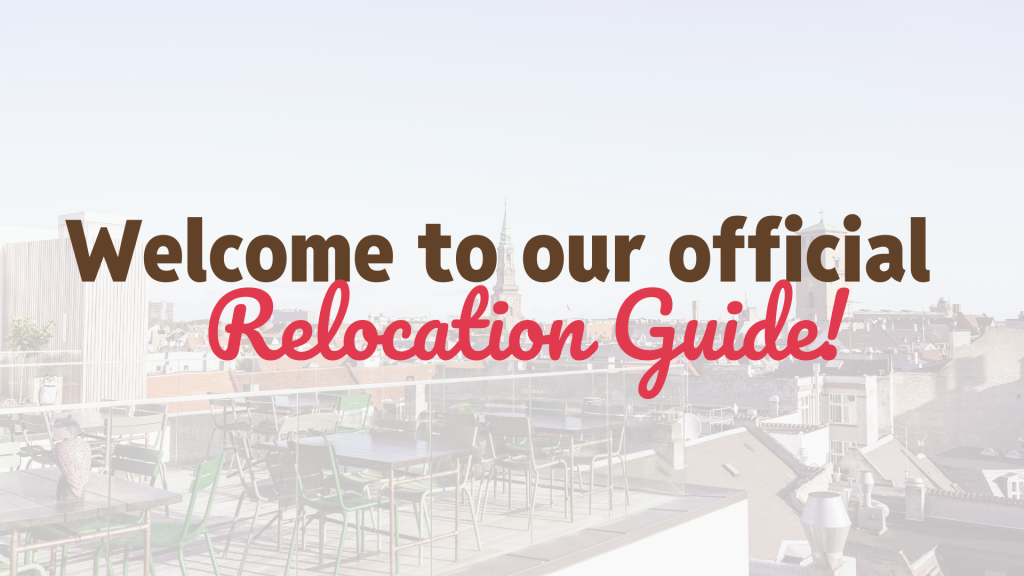
🗣️ If you’re currently in the interview process with Tactile
If you are currently based outside of Denmark and are considering to move here, there is some key information that is good to know very early on.
Already in the initial conversations during the recruitment process, we like to cover the following:
- Your salary expectations
- Your availability
- What is Office Life like at Tactile
- Practicalities surrounding relocation (i.e. would you be moving with a partner, a pet or family?)
For things like salary, it is important to look at market ranges and general life costs, so that you understand what level of life a certain compensation package can secure you. It is important to put this number into the context of Copenhagen/Denmark.
1️⃣ Section 1 of our Relocation Guide (pages 4-11) will help you to do so! 👌
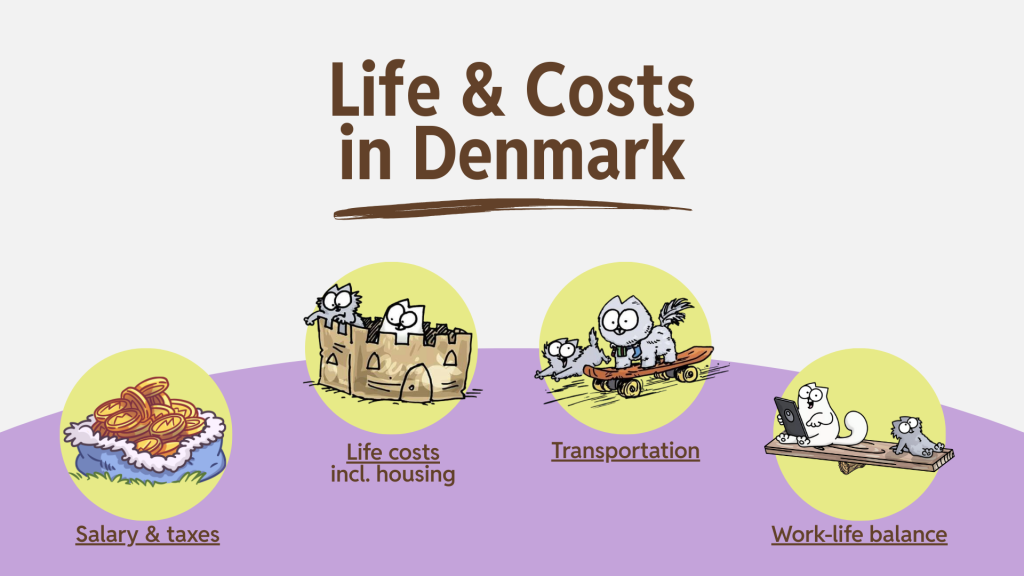
🤝 If you’ve signed the contract and are about to move to Denmark
Big congrats on your offer! We’re looking forward to welcoming you to our Tactile team very soon! 🥳
Now it’s time to kick-start your relocation process 👏
Our People Coordinator will reach out to you via e-mail to get all the details we need to apply for your visa (if required), book your flights and temporary accommodation, and to help relocate any accompanying family members.
2️⃣ Section 2 of our Relocation Guide (pages 12-23) will help to set your expectations regarding the relocation process with Tactile.
💡For a complete overview, please visit Life in Denmark.
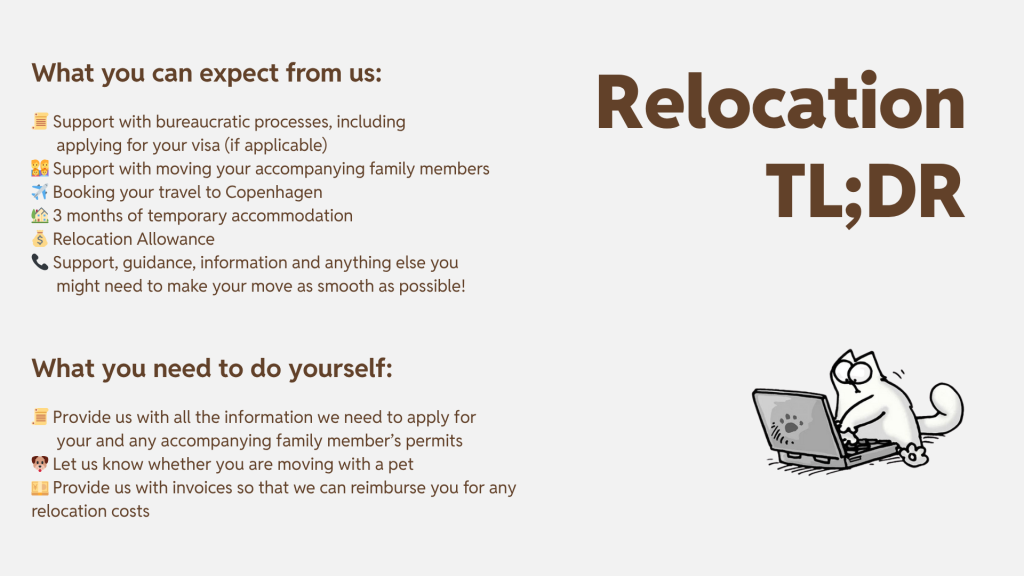
✈️ If you have just arrived to Copenhagen
You made it to Denmark! Velkommen ❤️
Now we have to get you set up with all the practical stuff. There are a lot of bureaucratical processes in Denmark, but it’s pretty straightforward to sail through them and our People Coordinator will be there to support you throughout the entire journey. Once you receive your civil registration number (CPR) and yellow health card, you’re pretty much good to go 👏 You’ll be able to open a bank account, access your health insurance, receive salary, pay tax, create your digital ID and even borrow books from the library 😄
3️⃣ In Section 3 of the Relocation Guide (pages 24-39), we go over what the standard bureaucratic process looks like, depending on where you come from (Non-EU or EU).
💡For a complete overview please visit the International House.
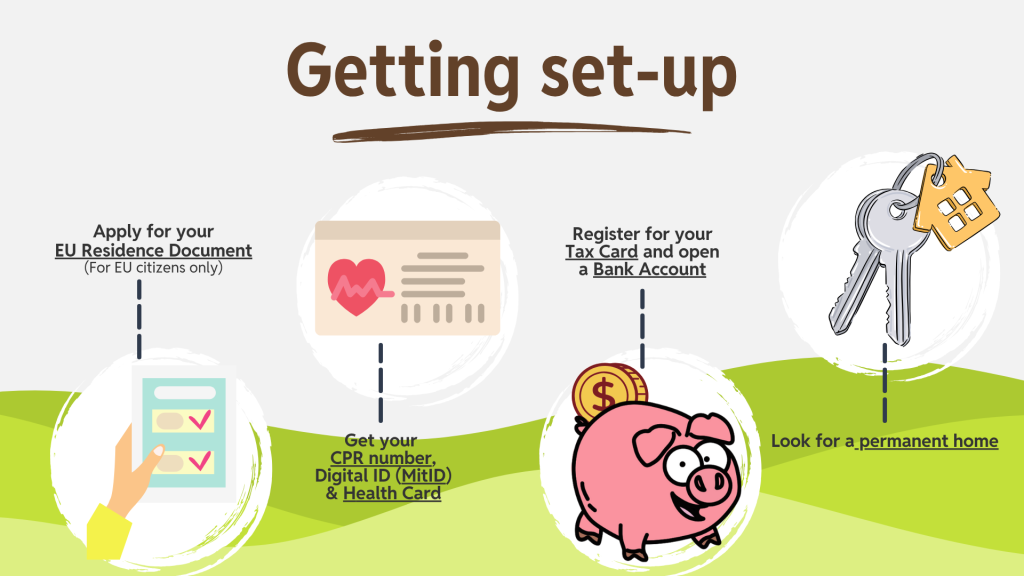
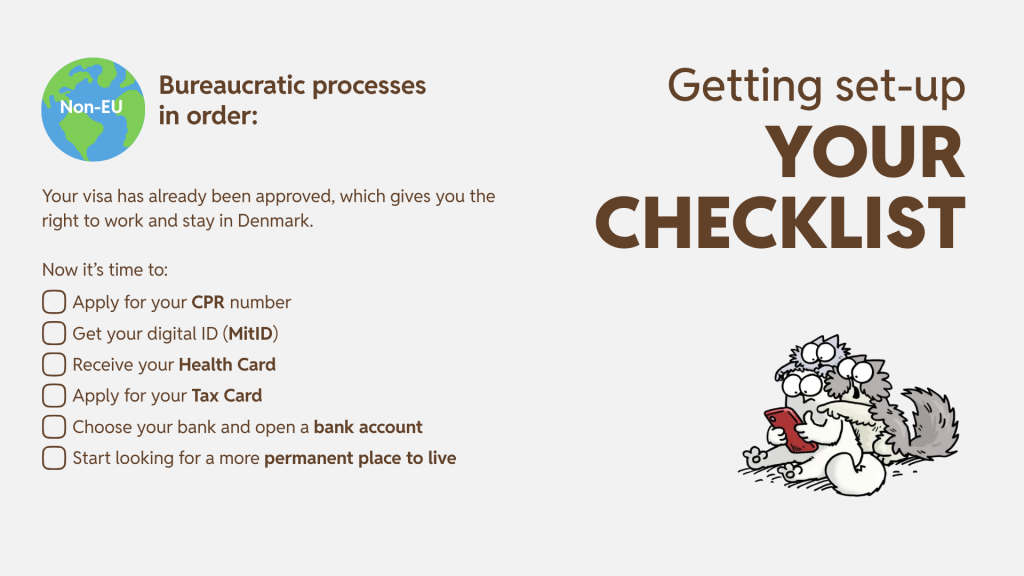
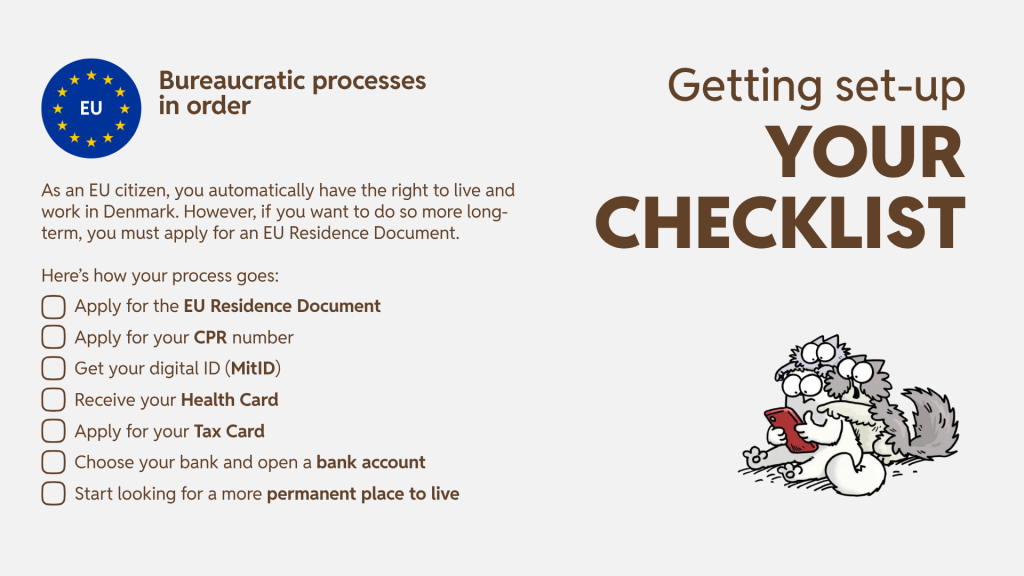
Do not worry – we know this is a looooot of information and it can be overwhelming to take it all in – we are here to support you every step of the way. You will receive all the information again when it’s relevant, so that you don’t have to think about everything all at once.
This Relocation Guide is here to support you wherever in your recruitment journey you might be and it serves as your go-to place to find any information which you might need. We also invite you to check out our Relocation to Denmark FAQs.
💡In general, Danish authorities provide a lot of useful information online, and we very much recommend that you consult those too. We recommend:
- Ny i Danmark (New to Denmark) – The official portal for foreign nationals who wish to visit, live or work in Denmark
- International House – Your one-stop for registration services, events, and career programmes to welcome you as a newcomer in Copenhagen and many other municipalities
- SIRI – The Danish Agency for International Recruitment and Integration
- Life in Denmark (via Borger.dk) – The official guide to life in Denmark
- Borger.dk (Citizen information) – Your digital gateway to the public sector including information on what to do 🏠 when you move, 🩺 when you need to go to the doctor, 🏖️ when you want to take vacation or apply for other benefits, 👶 when you become a parent, 💰 when you want to invest into your pension, and loads more!
- Skat – Danish tax agency
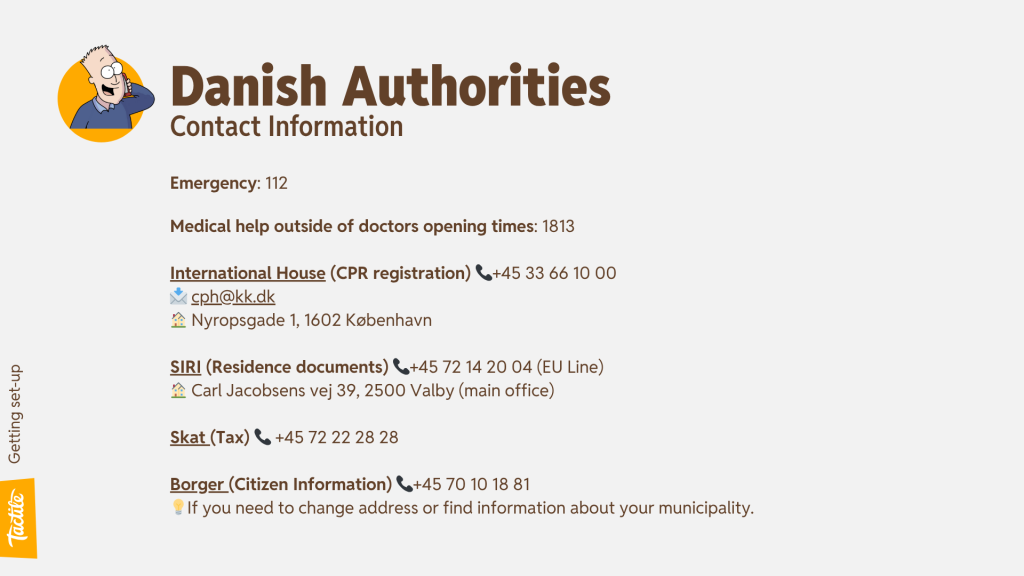
Good luck with your move! 🍀
It’s Time for Talent – with Asker Markussen
Hi, my name is Asker, it’s nice to e-meet you! 👋
I initially joined Tactile in 2021 as a 3D Character Animator in the Creative Marketing department. A couple of years later, I got the opportunity to move to game production, where I now work as the Lead Animator on one of our newest games. In my role, I oversee all animation and work closely with the art team to create a fun experience for our players.
🚀 Before Tactile
I was always glued to the screen as a kid. Playing video games and watching every animated show I could find, so it was always my dream to work in games and movie production.
After high school, I knew I needed to grow not just as an animator, but also as a person. I enrolled in an online animation school at Animation Mentor and started a university program in software development at ITU at the same time. It was a lot of work, to say the least, but I learned so much.
After finishing the online animation course, I was offered a job at Tactile Games. Without much hesitation, I took a big risk and dropped out of university to work at Tactile full-time as a character animator.
💜 Joining Tactile
When I joined, I was totally green when it came to working full time in a professional environment and working as a 3D animator, so there was plenty of growing to do! Luckily, the whole team in Creative Marketing made sure to take good care of me. People are extremely supportive here. Feedback and daily communication is essential to the development of the employees and the work we do at Tactile.
Joining tactile had a great impact on my growth as an animator. This was the first time I had been surrounded by like minded people who were all interested in creating art and animation and were all motivated to learn and grow their craft.
💪 Having an impact
I am currently on a team working on one of our new games. I spend most of my time animating in Maya, giving feedback and implementing art and assets in Unity. It is a great mix between artistic and technical skills that I find very fun and there is always more to learn.
My favorite part of working with a new, smaller team is that experimentation and fast iteration is possible. It is so much fun to see great ideas have an impact on the final product and that everyone can work together and collaborate on a specific vision.
It is also very rewarding to see your hard work become part of a bigger product and how a lot of work and polish can take a game from good to great.
📚 The keys to success
If you are looking to get into animation in the gaming industry here’s some tips from my experience:
- Master the basics. In gaming, animations are often short and precise and each animation will be seen dozens or even thousands of times by each player, so every movement matters.
- I think now more than ever it is important to be open minded and curious about new tools and work flows, and embrace disciplines outside of your comfort zone.
- AI is one of the biggest shifts we’ve seen and while it comes with plenty of unknowns, it also opens up exciting new possibilities for animators and artists alike.
Thanks for sharing, Asker! 💜
It’s Time for Growth – with Vera Kozlenko
At Tactile, we encourage our team members to take ownership of their own development and drive their upskilling to match the needs of the company, as well as their own aspirations.
The desire to upskill oneself is crucial for the success of our business, so having team members with that mindset is what we believe is part of pushing us forward.
We chatted to our UI Game Artist, Vera Kozlenko, to learn more about how she grew into the most passionate AI Artist within the company 👏
Read more about how she upskills by blending UI and AI below 🚀
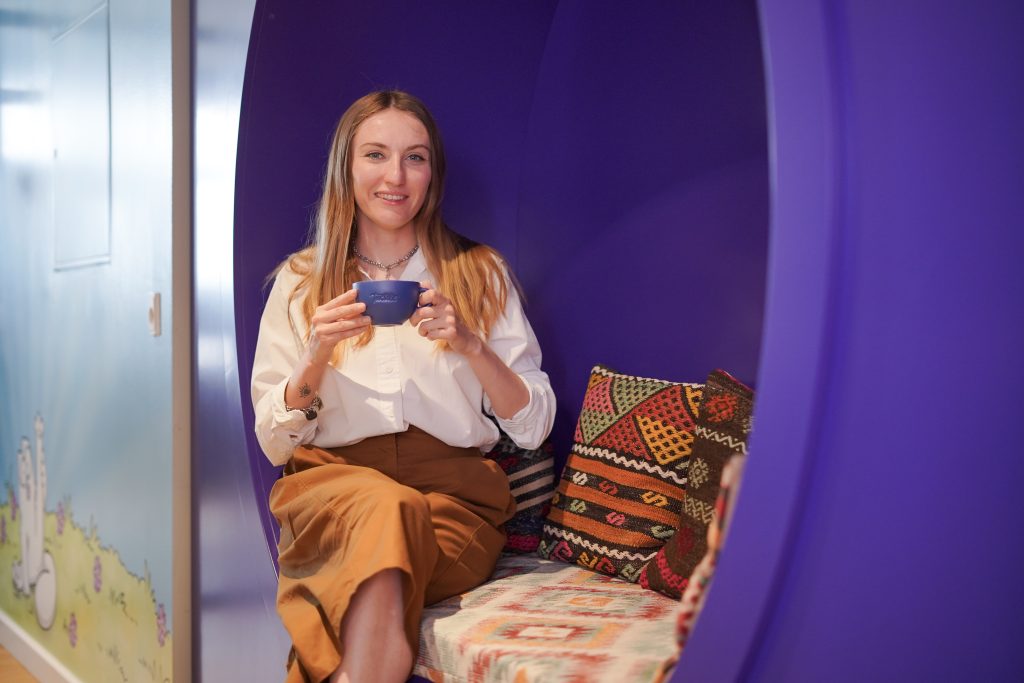
Tactile: Hi Vera, can you tell us a little bit about what your role was when you started at Tactile?
Vera: I initially applied for a 2D Artist position but was instead offered the role of a UI Artist.
In this capacity, I joined Lily’s Garden Product team, where I worked on creating new in-game features and other UI-related elements, contributing directly to the game’s user experience and visual polish.
Tactile: How have you grown and developed in your role since then?
Vera: Although my background was originally focused on illustration and 3D art, working on Lily’s Garden sparked my interest in expanding my technical expertise.
I closed all knowledge gaps on my own and significantly improved my Unity and animation skills. Over time, I moved to creating animations directly in Unity, and in recent months, I’ve grown passionate about experimenting with shaders to create visual effects.
Tactile: So how did you end up diving deeper and deeper into the world of AI?
Vera: I have a Master’s in Mathematics and Applied Computer Science, so I’ve always been drawn to both the visual and technical sides of art. Working as a UI Artist gave me the ideal opportunity to combine my strong technical foundation with a creative role, especially now with the rise of AI tools. I explored how other artists use AI in their workflows and was inspired by the quality and originality of their results.
The ComfyUI interface didn’t intimidate me, so I was very curious, motivated and felt a strong drive to innovate. And so I began setting aside 1–2 days each sprint to learn and experiment with new AI models. This self-driven exploration helped me bring technical innovation into our production pipeline and evolve my creative process.
It works great for concept art.
Tactile: How has your day-to-day changed since you incorporated more AI into your workflows?
Vera: I continue to work as a UI Artist, but AI has become a core part of my daily workflow. I use our in-house plugin for prototyping, sketching, and polishing assets. I can now create any asset using AI alone, or combine it with 3D or 2D, depending on the needs of the project. I really enjoy working with image-to-image workflows – taking a sketch or a 3D model and turning it into a polished, visually appealing result.
For one task, I generated a depth map from my 3D model and used a ControlNet-based workflow to let AI handle the color pass. It helped me to quickly explore and find color combinations I really liked.
I tested it for fun, but in the end, I just finished the chests by hand.
My daily routine has also evolved: I help to maintain our internal AI tools, monitor the status of our AI machines and our custom Tactile Photoshop plugin, and make sure everything runs smoothly. I assist artists when something breaks or gets stuck, run short training sessions, and support anyone interested in using AI in their creative workflow.
Tactile: Do you have any tips for artists learning about how they can use AI in their work? Where is a good place to start?
Vera: If you’re just starting to explore AI in art, my advice is: watch how other artists work. See what models they use, how they build their pipelines, and what kind of results they get. Take a moment to reflect on what exactly you admire in their results, and try to understand what personally resonates with you in those interests. For example, I never used to enjoy creating characters, but now the idea of designing one doesn’t feel intimidating anymore.
When it comes to more technical topics, my advice is this: try building your own workflows with Stable Diffusion or Flux using ComfyUI. Start with something simple like text-to-image, then move on to image-to-image, learn masks, and so on. That’s the foundation. After that, you can explore custom styles and more advanced setups.
Don’t expect perfect results right away – that’s totally normal. It takes time to understand how to get the look you want. And most importantly, remember: AI is just another tool. It won’t replace your creativity, but it can help you work faster, try new things, and bring your ideas to life in new ways.
Tactile: What do your development plans look like for the future?
Vera: I’m excited to explore new AI models for 3D and video generation. It’s a direction I want to spend more time on in the coming months. I’m especially interested in models that can run locally in ComfyUI. For now, I’m focused on testing the latest updates to the model we use, since staying up to date is essential when things are moving this fast.
Thank you for the lovely chat, Vera 💜
